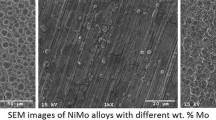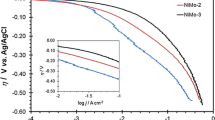Abstract
In this paper, a nickel anode was used for Ga electrowinning in the presence of S2− ions. The corrosion resistances of nickel and stainless steel electrodes in alkaline solutions of S2− were studied by cyclic voltammetry, XPS, and weight loss measurements. Ga electrowinning was carried out in Ga solutions with high concentrations of S2− at different current densities and NaOH concentrations. The results indicated that the nickel anode showed better corrosion resistance than the stainless steel anode. The corrosion rate of nickel was much lower than that of stainless steel due to the formation of stable passive films consisting of Ni oxide and hydroxide. The corrosion rate of the nickel anode was only 0.28 mg cm−2 after 48 h electrowinning in the presence of 5 g L−1 S2− ions. The corrosion resistance of the nickel anode was almost independent of the NaOH concentration and the current density. When the nickel anode was used for Ga electrowinning, the current efficiency (QE) decreased in the presence of S2− owing to the reduction of the incomplete oxidation products of S2− on the cathode. The complete oxidation of S2− to SO4 2− was accelerated on the nickel anode, which lowered the concentrations of S2− and that of its incomplete oxidation products in solution. Bright, high-purity metallic gallium was obtained when using the nickel anode, even in Ga(III) solutions of 5 g L−1 S2−. Therefore, nickel was a suitable anode material for Ga electrowinning in Ga solutions of S2− ions.










Similar content being viewed by others
References
Moskalyk RR (2003) Gallium: the backbone of the electronics industry. Miner Eng 16:921–929
Bhattacharya RN, Hiltner JF, Batchelor W, Contreras MA, Nou RN, Sites JR (2000) 15.4 % CuIn(1−x)Ga(x)Se(2)-based photovoltaic cells from solution-based precursor films. Thin Solid Films 361:396–399
Zhang L, Jiang FD, Feng JY (2003) Formation of CuInSe2 and Cu(In, Ga)Se2 films by electrodeposition and vacuum annealing treatment. Sol Energy Mater Sol Cells 80:483–490
McGary PD, Reddy KSM, Haugstad GD, Stadler BJH (2010) Combinatorial electrodeposition of magnetostrictive Fe1−xGax. J Electrochem Soc 157:656–665
Yamamoto N, Makino H, Osone S, Ujihara A, Ito T, Hokari H, Maruyama T, Yamamoto T (2012) Development of Ga-doped ZnO transparent electrodes for liquid crystal display panels. Thin Solid Films 520:4131–4138
Zhao Z, Yang YX, Xiao YP, Fan YQ (2012) Recovery of gallium from Bayer liquor: a review. Hydrometallurgy 125:115–124
Seredin Vladimir V, Dai SF, Sun YZ, Chekryzhov Igor Y (2013) Coal deposits as promising sources of rare metals for alternative power and energy-efficient technologies. Appl Geochem 31:1–11
Riveros PA (1990) Recovery of gallium from bayer liquors with an amidoxime resin. Hydrometallurgy 25:1–18
Yao ZT, Xia MS, Sarker PK, Chen T (2014) A review of the alumina recovery from coal fly ash, with a focus in China. Fuel 120:74–85
Salvarezza RC, Videla HA, Arvía AJ (1982) The electrodissolution and passivation of mild steel in alkaline sulphide solutions. Corros Sci 22:815–829
Shoesmith DW, Taylor P, Bailey MG, Ikeda B (1978) Electrochemical behaviour of iron in alkaline sulphide solutions. Electrochim Acta 23:903–916
Abd El Haleem SM, Abd El Aal EE (2007) Electrochemical reduction of the corrosion products formed on copper surface in alkaline-sulphide solutions. J Alloys Compd 432:205–210
Magaña Zavala C, Angeles San Martin ME, Rodríguez Gómez FJ, Acosta DR, Avila Godoy R, López-Suárez A (2010) Comparative study of the morphological degradation in nickel thin films exposed to H2S media and deposited by magnetron sputtering and electrolytic process. Surf Eng Appl Electrochem 46:115–119
Reda MR, AlHajji JN (1993) Effect of trace organic compounds on the corrosion of Cu/Ni alloys in sulfide polluted seawater. Ind Eng Chem Res 32:960–965
Awad NK, Ashour EA, Fouda AS, Allam NK (2014) Effect of alloying elements on the electrochemical behavior of Cu–Ni–Zn ternary system in sulfide-polluted saltwater. Appl Surf Sci 307:621–630
Tang XY, Wang SZ, Xu DH, Gong YM, Zhang J, Wang YZ (2013) Corrosion behavior of Ni-based alloys in supercritical water containing high concentrations of salt and oxygen. Ind Eng Chem Res 52:18241–18250
Liu L, Wang MY, Wang Z, Zhang Y (2014) The influence of impurities on Ga electrowinning: vanadium and iron. Hydrometallurgy 146:76–81
Hamilton IC, Woods R (1983) An investigation of the deposition and reactions of sulphur on gold electrodes. J Appl Electrochem 13:783–794
Mao Z, Anani A, White RE, Srinivasan S, Appleby AJ (1991) A modified electrochemical process for the decomposition of hydrogen sulfide in an aqueous alkaline solution. J Electrochem Soc 138:1299–1303
El Haleem SMA, El Aal EEA (2008) Electrochemical behaviour of iron in alkaline sulphide solutions. Corros Eng Sci Techn 43:173–178
Jayalakshmi M, Muralidharan VS (1992) Influence of sulphur on passivation of iron in alkali solutions. Corros 48:918–923
Yuan SJ, Liang B, Zhao Y, Pehkonen SO (2013) Surface chemistry and corrosion behaviour of 304 stainless steel in simulated seawater containing inorganic sulphide and sulphate-reducing bacteria. Corro Sci 74:353–366
Moulder JF, Stickle WF, Sobol PE, Bomben KD (1992) Handbook of X-ray photoelectron spectroscopy. Perkin-Elmer Corp, Eden Prairie, pp 56–80
Legrand DL, Nesbitt HW, Bancroft GM (1998) X-ray photoelectron spectroscopic study of a pristine millerite (NiS) surface and the effect of air and water oxidation. Am Mineral 83:1256–1265
Nesbitt HW, Legrand D, Bancroft GM (2000) Interpretation of Ni2p XPS spectra of Ni conductors and Ni insulators. Phys Chem Miner 27:357–366
Yuan SJ, Pehkonen SO (2007) Surface characterization and corrosion behavior of 70/30 Cu–Ni alloy in pristine and sulfide-containing simulated seawater. Corros Sci 49:1276–1304
Awe SA, Sandström Å (2013) Electrowinning of antimony from model sulphide alkaline solutions. Hydrometallurgy 137:60–67
Awe SA, Sundkvist JE, Sandström Å (2013) Formation of sulphur oxyanions and their influence on antimony electrowinning from sulphide electrolytes. Miner Eng 53:39–47
Dorin R, Frazer EJ (1988) The electrodeposition of gallium from synthetic bayer-process liquors. J Appl Electrochem 18:134–141
Cappadonia M, Divisek J, Vonderheyden T, Stimming U (1994) Oxygen evolution at nickel anodes in concentrated alkaline-solution. Electrochim Acta 39:1559–1564
Acknowledgments
This work is supported by the Natural Science Foundation of China (51422405, 51374192), the National Basic Research and Development Program of China (2013CB632606), and the Youth Innovation Promotion Association, CAS (2015036).
Author information
Authors and Affiliations
Corresponding authors
Rights and permissions
About this article
Cite this article
Liu, L., Wang, M., Wang, Z. et al. The corrosion resistance of Ni anode and Ga electrowinning in alkaline sulfide solutions. J Appl Electrochem 45, 1255–1263 (2015). https://doi.org/10.1007/s10800-015-0885-1
Received:
Accepted:
Published:
Issue Date:
DOI: https://doi.org/10.1007/s10800-015-0885-1




